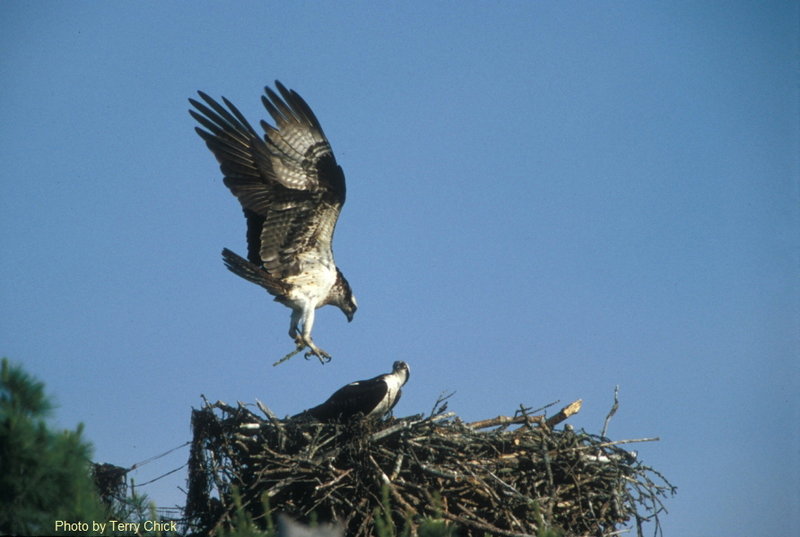For the past 28 years, Wolfe’s Neck Woods State Park manager Andy Hutchinson has known spring has arrived when the frolics of the ospreys are at hand.
On March 27, a male osprey claimed its old haunt in a big pine on Googins Island, which has hosted osprey about as long as anyone can remember. In fact, the island, renamed in the 1800s, was once called Fish Hawk Island. Ospreys are sometimes referred to as fish hawks.
“The park was established in 1969,” Hutchinson said. “According to neighbors, some who are in their 90s, osprey have been nesting on the island since they were little kids.”
Hutchinson said ospreys mate for life and arrive on a pretty precise schedule each and every year. The male always returns first, about a week to 10 days before his mate. Ospreys are long-distance travelers and winter in southern climates like Brazil.
“The male comes back early to establish nesting territory and to defend it,” Hutchinson said. “They reuse the same nest every year.”
Apparently the male didn’t dally this year in defending his seasonal home. As Hutchinson watched on the first day of the osprey’s return, three immature bald eagles flew by in formation. The osprey quickly drove them off.
Eagles are year-round residents of Wolfe’s Neck. Hutchinson said the interaction between the two species this time of year always adds a little drama to the area since eagles nest here each year, too, and will often commandeer an empty osprey nest.
“They’re both hunting fish, so there’s some competition there as well,” he said. “But mainly the competition is over the nesting sites. And it’s usually ospreys defending an old nest from eagles. Ospreys don’t typically try to take over an eagle’s nest.”
While ospreys have been residents of the island as long as anyone can remember, eagles have only called the park home for about the last 10 years, which reflects the general success the national bird has achieved statewide.
Eagles do not migrate, Hutchinson said. Local residents as well as game wardens put out food for the eagles here in the winter. Wardens will drop off roadkill, while fishermen will leave so-called trash fish out on the ice.
Eagles and ospreys have different fishing techniques and Hutchinson said it’s always a thrill to watch the birds at work.
“Osprey can hover because of the little crook in their wings,” Hutchinson said. “They can spot prey from 150 feet in the air. Then they just plunge; they dive-bomb.”
Much like a falcon, an osprey will tuck its wings and dive, or stoop headfirst. It’s only when the bird is just seconds from the water’s surface that it gets its talons out and plunges feet-first into the water to seize a fish. With long legs, an osprey will sometimes grasp a foot or two beneath the surface for a meal.
“Sometimes we’ll see them take a flounder in the salt marsh,” Hutchinson said. “It’s an incredible sight to see that plunge; they’re amazing fishermen.”
By contrast, eagles are much bigger and have a different tactic. Instead of hovering and then dive-bombing, Hutchinson said, an eagle is like a flying fortress, approaching the water on a low glide and quickly snatching its prey.
The park typically hosts two pairs of ospreys: one on Googins Island and another twosome on the mainland.
Over the weekend of April 28-29 at both Wolfe’s Neck Woods and Bradbury Mountain state parks, you can see these birds of prey at work during the second annual Feathers over Freeport, an all-ages birding event featuring numerous activities. An osprey watch on the 29th from 10 a.m. to 2 p.m. will be part of the activities.
For more about Feathers over Freeport, visit: www.maine.gov/feathersoverfreeport, or call Wolfe’s Neck at 865-4465.
Don Perkins is a freelance writer who lives in Raymond. He can be reached at:
presswriter@gmail.com
Send questions/comments to the editors.



Success. Please wait for the page to reload. If the page does not reload within 5 seconds, please refresh the page.
Enter your email and password to access comments.
Hi, to comment on stories you must . This profile is in addition to your subscription and website login.
Already have a commenting profile? .
Invalid username/password.
Please check your email to confirm and complete your registration.
Only subscribers are eligible to post comments. Please subscribe or login first for digital access. Here’s why.
Use the form below to reset your password. When you've submitted your account email, we will send an email with a reset code.